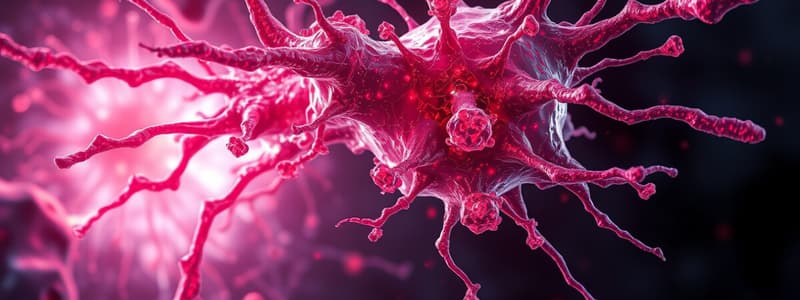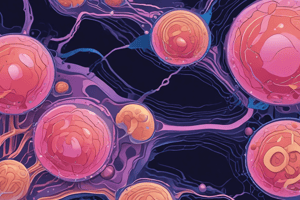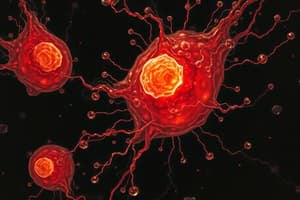Podcast
Questions and Answers
What are the two fundamental processes essential for metastasis and how do they affect cancer cells?
What are the two fundamental processes essential for metastasis and how do they affect cancer cells?
The two fundamental processes are epithelial-mesenchymal transition (EMT) and mesenchymal-epithelial transition (MET). They enable cancer cells to change their phenotype, allowing them to migrate and invade surrounding tissues.
Explain why metastasis is considered a hallmark of malignant tumors and not of benign tumors.
Explain why metastasis is considered a hallmark of malignant tumors and not of benign tumors.
Metastasis is a characteristic of malignant tumors because they have the ability to invade other tissues and form secondary tumors. In contrast, benign tumors remain localized and do not spread to other parts of the body.
What role does angiogenesis play in the process of metastasis?
What role does angiogenesis play in the process of metastasis?
Angiogenesis is crucial for metastasis as it aids the growth of new blood vessels, supplying nutrients and oxygen to tumors, facilitating their expansion. It also prepares the environment for metastatic spread.
Define metastasis and discuss its implications for patient prognosis.
Define metastasis and discuss its implications for patient prognosis.
What is meant by 'organ tropism' in the context of metastases?
What is meant by 'organ tropism' in the context of metastases?
What are the common sites for metastasis from malignant lung cancer?
What are the common sites for metastasis from malignant lung cancer?
How can secondary tumors be identified as metastases rather than primary tumors?
How can secondary tumors be identified as metastases rather than primary tumors?
What factors determine why only some tumors metastasize more easily?
What factors determine why only some tumors metastasize more easily?
In what way does the metastatic process demonstrate inefficiency despite cancer cell release from the primary tumor?
In what way does the metastatic process demonstrate inefficiency despite cancer cell release from the primary tumor?
What is the significance of the 'metastatic phenotype' in tumor subpopulations?
What is the significance of the 'metastatic phenotype' in tumor subpopulations?
What role does clonal evolution play in the metastasis of tumors?
What role does clonal evolution play in the metastasis of tumors?
What strategies do tumor cells use to escape the immune response during vascular dissemination?
What strategies do tumor cells use to escape the immune response during vascular dissemination?
What role do adhesion molecules play in the metastatic process?
What role do adhesion molecules play in the metastatic process?
Why can the metastatic process be inefficient?
Why can the metastatic process be inefficient?
What factors promote the engraftment of metastases in the body?
What factors promote the engraftment of metastases in the body?
What is indicated as the metastatic signature and which type of cancer has shown a similarity to this signature?
What is indicated as the metastatic signature and which type of cancer has shown a similarity to this signature?
Describe the vascular route of metastasis.
Describe the vascular route of metastasis.
Explain how the tumor stroma influences metastasis development.
Explain how the tumor stroma influences metastasis development.
What are the two main routes for malignant tumor cells to disseminate?
What are the two main routes for malignant tumor cells to disseminate?
Describe the significance of epithelial-mesenchymal transition (EMT) in the metastatic cascade.
Describe the significance of epithelial-mesenchymal transition (EMT) in the metastatic cascade.
What specific tumor types primarily use the vascular route for metastasis?
What specific tumor types primarily use the vascular route for metastasis?
List the first three steps involved in the process of metastasization.
List the first three steps involved in the process of metastasization.
In what way do tumor cells stimulate platelet aggregation?
In what way do tumor cells stimulate platelet aggregation?
How do mutations relate to the metastatic variants observed in tumors?
How do mutations relate to the metastatic variants observed in tumors?
How do tumor cells escape from blood vessels during the metastatic process?
How do tumor cells escape from blood vessels during the metastatic process?
What role do immune cells play during the metastasis process?
What role do immune cells play during the metastasis process?
In what way does the loss of E-cadherin contribute to cancer cell metastasis?
In what way does the loss of E-cadherin contribute to cancer cell metastasis?
Differentiate between metastasization and metastasis regarding their definitions in the context provided.
Differentiate between metastasization and metastasis regarding their definitions in the context provided.
What role do the liver and lungs play in the metastasis of tumors originating from the gastrointestinal tract?
What role do the liver and lungs play in the metastasis of tumors originating from the gastrointestinal tract?
How do tumor cells typically use lymphatic routes to spread from primary sites, and what are the potential outcomes?
How do tumor cells typically use lymphatic routes to spread from primary sites, and what are the potential outcomes?
Describe the significance of one surviving cancer cell in the context of metastasis.
Describe the significance of one surviving cancer cell in the context of metastasis.
What distinguishes the three types of metastasis mentioned, and how does the origin of the tumor influence the metastatic pathway?
What distinguishes the three types of metastasis mentioned, and how does the origin of the tumor influence the metastatic pathway?
Explain why lymph nodes can become involved in metastasis and what immune response they generate.
Explain why lymph nodes can become involved in metastasis and what immune response they generate.
What role do proteolytic enzymes, like metalloproteases, play in cancer cell migration?
What role do proteolytic enzymes, like metalloproteases, play in cancer cell migration?
Explain the significance of epithelial to mesenchymal transition (EMT) in the metastatic process.
Explain the significance of epithelial to mesenchymal transition (EMT) in the metastatic process.
How does low environmental pH influence tumor invasion?
How does low environmental pH influence tumor invasion?
Describe the process of mesenchymal to epithelial transition (MET) in metastasis.
Describe the process of mesenchymal to epithelial transition (MET) in metastasis.
What is the function of integrins in the metastatic cascade?
What is the function of integrins in the metastatic cascade?
Why is the communication between tumor cells and their microenvironment important?
Why is the communication between tumor cells and their microenvironment important?
Discuss the impact of inflammation on tumor development.
Discuss the impact of inflammation on tumor development.
What are the phases involved in the metastatic cascade?
What are the phases involved in the metastatic cascade?
How do tumor cells adapt their ATP production under anaerobic conditions?
How do tumor cells adapt their ATP production under anaerobic conditions?
What mechanisms allow neoplastic cells to detach from the primary tumor?
What mechanisms allow neoplastic cells to detach from the primary tumor?
Study Notes
Metastases Overview
- Metastasis refers to the formation of secondary tumors from malignant tumors, distinct from the primary site of origin.
- Only malignant tumors can metastasize; benign tumors do not exhibit this ability.
- Metastases are responsible for 90% of cancer mortality, indicating poor prognosis for patients with metastasis.
Cell Transformation and Mechanisms
- Cancer cells undergo epithelial to mesenchymal transition (EMT), allowing detachment from the primary tumor and enhanced mobility.
- Malignant tumors can spread to other tissues through specific routes, termed "metastatic routes."
- Organ tropism explains why certain tumors preferentially metastasize to specific organs (e.g., lung cancer often spreads to the brain and bones).
Characteristics of Secondary Tumors
- Secondary tumors exhibit similar morphological, biochemical, and behavioral characteristics as the primary tumor.
- Distinguishing primary from secondary tumors involves assessing cell morphology; for instance, breast cancer cells in lung tissue indicate metastasis rather than a primary lung tumor.
Factors Influencing Metastatic Potential
- Tumors are heterogeneous, comprised of subpopulations of cells, some of which acquire "metastatic potential" due to specific gene expressions and mutations.
- Not all cancer cells within a tumor can metastasize; clonal evolution leads to the emergence of variants with greater metastatic abilities.
Theories of Metastasis
- Rare variant clones within primary tumors acquire mutations enabling metastasis, suggesting a higher likelihood of metastasis in these subclones.
- A majority of tumor cells may carry a "metastatic signature," allowing for the potential development of metastasis during cancer progression.
- Microenvironment factors, including tumor stroma and immune cells, significantly influence the metastatic process.
Metastatic Cascade Steps
- The metastatic process consists of multiple sequential steps:
- Cell Detachment: Tumor cells breach cell adhesion through reduced production of adhesion molecules such as E-cadherins.
- Basement Membrane Disruption: Cells undergo changes to traverse the extracellular matrix (ECM).
- Cell Motility: Increased motility enables tumor cells to migrate away from the primary tumor through the EMT process.
- Invasion: Tumor cells invade local tissues and reach the blood or lymphatic systems, termed "intravasion."
- Circulation and Arrest: Tumor cells circulate and eventually station at secondary sites, continuing their invasive trajectory.
The Role of Tumor Microenvironment
- Communication between tumor cells and their surrounding microenvironment is vital for invasion and metastatic success.
- Angiogenesis and lymphangiogenesis support tumor survival by creating blood and lymphatic supply networks in secondary sites.
Key Molecular and Cellular Changes
- Tumor cells switch from an epithelial to a more migratory mesenchymal phenotype during the initial phases of metastasis (EMT).
- To complete metastasis, cells may revert to an epithelial state through mesenchymal to epithelial transition (MET), establishing new tumor growth.
- The microenvironment continues to facilitate tumor progression through various mechanisms, including inflammation-associated processes, influencing the behavior and survival of metastatic cells.### Metastatic Process
- Tumor cells migrate through the extracellular matrix (ECM) and enter blood circulation or the lymphatic system.
- Tumor cells must evade both natural and acquired immune defenses to survive in circulation.
- Formation of solid neoplastic emboli allows tumor cells to escape immune detection by masking themselves with platelets.
- Tumor cells arrest in the blood stream by adhering to endothelial cells using specific adhesion molecules.
- Extravasion occurs when tumor cells escape from blood vessels through the basement membrane, enabling tissue invasion.
Proliferation and Angiogenesis
- Arrested tumor cells proliferate in the surrounding tissues and produce angiogenic factors like VEGF.
- Angiogenic factors stimulate fibroblast and endothelial cell proliferation, supporting tumor growth and vascularization essential for metastasis development.
Inefficiencies in the Metastatic Process
- Metastasis involves complex steps, each presenting challenges that can lead to tumor cell death before forming secondary tumors.
- Various events can either facilitate or inhibit successful metastasis formation.
Factors Favoring Metastatic Engraftment
- Immunosuppressive factors hinder immune responses, allowing tumor cells to survive.
- Alterations in natural killer (NK) cell functionality decrease tumor cell recognition and destruction.
Types of Cellular Interactions
- Homophilic Binding: Tumor cells adhere to one another through proteins like E-cadherin and CAM.
- Heterophilic Binding: Tumor cells interact with platelets, forming aggregates that aid in evading immune surveillance.
- Adhesion molecules such as integrins, fibronectin, and collagens are crucial for tumor cell migration and anchorage.
Modalities of Metastatic Dissemination
- Vascular Route: Tumors spread through blood (common in sarcomas, certain carcinomas).
- Lymphatic Route: Primarily involves carcinomas; cancer cells easily breach lymphatic capillaries.
- Transcoelomic Route: Involves spread through serous membranes in body cavities.
- Contact/Contiguity: Tumor cells spread from one organ to another adjacent organ.
- By Grafting: Accidental dissemination during surgical procedures can lead to metastasis.
Organ Tropism of Metastatic Localization
- Certain primary tumors have preferential sites for metastasis (e.g. lungs and liver as common arrest points).
- Factors influencing metastasis localization include blood flow direction, organ blood supply, and local tissue conditions.
- Local hydrodynamic factors (e.g., stiff tissues like bones favor metastasis due to their high blood supply).
Specific Tumor Types and Their Routes
- Sarcomas and some carcinomas, like breast cancer, utilize both vascular and lymphatic routes for spread.
- Portal Vein Type: Involves metastasis from GI tract tumors to the liver.
- Vena Cava Type: Tumor cells from any organ can reach the lungs.
- Lung Vein Type: Lung tumors can spread throughout the body through systemic circulation.
Conclusion on Metastasis
- Predicting metastatic sites can be guided by the primary tumor location and local biological conditions, but it remains a complex and variable process influenced by numerous factors.
Studying That Suits You
Use AI to generate personalized quizzes and flashcards to suit your learning preferences.
Description
This quiz explores the processes of epithelial-mesenchymal transition (EMT) and mesenchymal-epithelial transition (MET) crucial for metastasis in cancer. It highlights how epithelial cells alter their phenotype to migrate and invade surrounding tissues, emphasizing the significance in malignancies like carcinoma.





